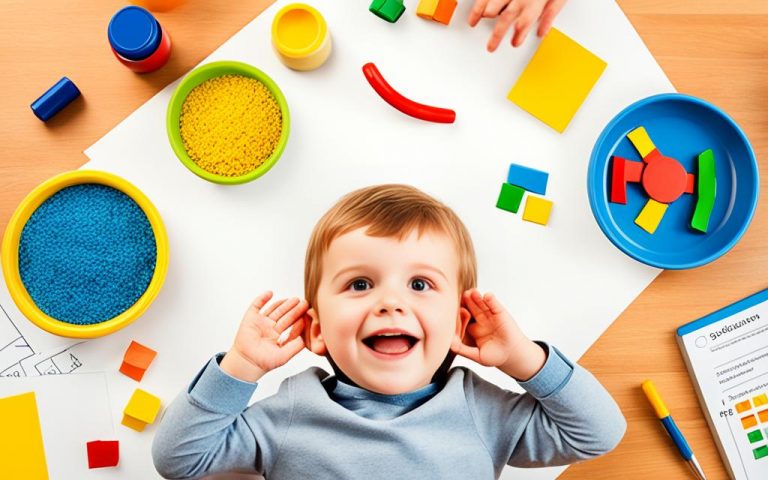Sensory Integration: A Method of Work with Pre-School
Sensory integration is a valuable approach to address sensory processing disorders in pre-school and early stage education. By focusing on enhancing children’s learning capabilities, it aims to overcome difficulties in functioning, behavior, and learning. This method involves diagnosing and treating sensory integration disorders in children with various health and developmental challenges. Sensory integration therapy can be particularly beneficial for children with sensory seeking behaviors or sensory motor processing disorders.
Key Takeaways:
- Sensory integration is an effective method for addressing sensory processing disorders in pre-school and early stage education.
- It aims to enhance children’s learning capabilities and overcome difficulties in functioning, behavior, and learning.
- Children with sensory seeking behaviors or sensory motor processing disorders can benefit from sensory integration therapy.
- Sensory integration therapy helps improve sensory processing abilities, regulate sensory responses, and enhance overall functioning.
- Implementing sensory integration in the classroom can create a supportive and inclusive learning environment.
Understanding Sensory Integration Disorders
Sensory integration disorders are characterized by difficulties in processing and interpreting sensory information from the environment. Children with these disorders may exhibit sensory seeking behaviors, such as constantly touching or mouthing objects, and have challenges regulating their responses to sensory stimuli. One common type of disorder is sensory motor processing disorder, which affects a child’s ability to coordinate their movements and interact effectively with their surroundings.
Children with sensory integration disorders may struggle with everyday activities that involve sensory input, such as dressing, eating, and social interactions. They may be hypersensitive to certain sounds, textures, or movements, or they may seek out intense sensory experiences to cope with their difficulties. These challenges can significantly impact their overall functioning, behavior, and learning in educational settings.
It is important to understand that sensory integration disorders are not simply a matter of being oversensitive or undersensitive to sensory stimuli. They involve complex neurological processes that affect how the brain receives, organizes, and responds to sensory information. By recognizing and acknowledging these disorders, parents, educators, and healthcare professionals can provide appropriate support and interventions to help children with sensory integration difficulties thrive.
Benefits of Sensory Integration Therapy
Sensory integration therapy, also known as sensory integration treatment, has been proven to provide numerous benefits for children with childhood sensory integration disorder. By addressing sensory processing difficulties, this therapy aims to improve sensory processing abilities, regulate sensory responses, and enhance overall functioning. Through targeted interventions, children can develop improved attention, concentration, and adaptive behaviors, leading to better participation and engagement in educational settings.
Research has shown that sensory integration therapy can have positive effects on children’s social skills and behavior. By addressing sensory processing disorders, this therapy helps children better understand and respond to sensory information from their environment, reducing sensory seeking behaviors and improving emotional regulation. This can lead to improved interactions with peers and increased confidence in social situations.
Moreover, sensory integration therapy can help children with childhood sensory integration disorder integrate into educational environments more effectively. By providing individualized interventions that target specific sensory difficulties, this therapy supports children’s sensory needs and promotes their overall development. By addressing sensory processing challenges, sensory integration therapy can create a supportive and inclusive learning environment where children can thrive.

The Benefits of Sensory Integration Therapy:
- Improves sensory processing abilities
- Regulates sensory responses
- Enhances attention and concentration
- Develops adaptive behaviors
- Improves social skills and behavior
- Promotes integration into educational settings
In conclusion, sensory integration therapy offers significant benefits for children with childhood sensory integration disorder. By addressing sensory processing difficulties, this therapy enhances children’s sensory abilities, regulation, and overall functioning. Through individualized interventions, children can develop essential skills for learning and social interaction, leading to improved educational outcomes and a better quality of life.
Sensory Integration Training and Education
Professionals who work with children with sensory processing disorders can benefit greatly from sensory integration training and education. By gaining a deeper understanding of sensory integration disorders and therapeutic approaches, practitioners can enhance their ability to support and facilitate children’s development and well-being. There are various avenues for obtaining sensory integration education and training.
Sensory Integration Online Courses
One option is to enroll in online courses that provide comprehensive knowledge about sensory integration disorders and therapeutic strategies. These courses offer illustrated PDFs and interactive modules that cover topics such as sensory processing disorders, assessment techniques, and intervention methods. Participants can learn at their own pace and receive a certificate of achievement upon completion.
Postgraduate Qualifications: PGCert and MSc
For individuals seeking a more in-depth education in sensory integration, there are postgraduate qualifications available. These qualifications, such as a Postgraduate Certificate (PGCert) or Master of Science (MSc) in Sensory Integration, provide accredited training from reputable universities. They offer a rigorous curriculum that delves into sensory integration theory, research, and clinical practice. Graduates of these programs gain the skills and knowledge necessary to become sensory integration practitioners.
| Training Program | Description |
|---|---|
| Sensory Integration Online Courses | Comprehensive online courses covering sensory integration disorders, assessment techniques, and intervention methods. Participants receive a certificate of achievement upon completion. |
| Postgraduate Certificate (PGCert) in Sensory Integration | An accredited postgraduate qualification offered by reputable universities. Provides in-depth training in sensory integration theory, research, and clinical practice. |
| Master of Science (MSc) in Sensory Integration | An advanced postgraduate degree that offers a comprehensive curriculum in sensory integration. Equips graduates with advanced knowledge and skills in the field. |
By pursuing sensory integration training and education, professionals can possess the necessary expertise to effectively assess, diagnose, and treat sensory processing disorders. This knowledge enables practitioners to tailor interventions and create individualized therapy plans that address the specific needs of each child. Through ongoing learning and professional development, sensory integration practitioners can continually enhance their skills and stay abreast of the latest research and advancements in the field.
Implementing Sensory Integration in the Classroom
Sensory integration plays a crucial role in creating a supportive and engaging learning environment for children with sensory processing disorders. By incorporating sensory integration techniques in the classroom, educators can cater to the unique sensory needs of each child, promoting their participation and enhancing their educational experience.
Creating a sensory-friendly classroom involves providing a variety of sensory experiences that stimulate different senses. For example, tactile materials such as textured surfaces or sensory bins filled with sensory objects can engage the sense of touch. Visual aids, such as visual schedules or calming visual cues, can help children with sensory processing disorders better understand and navigate their daily routines.
Movement opportunities are also essential for sensory integration in the classroom. Incorporating movement breaks or incorporating physical activities into lessons can help children regulate their sensory input and improve their focus and attention. For instance, using exercise balls as seating options or adding standing desks can provide opportunities for movement and help children with sensory processing disorders stay engaged in their learning.
“A sensory-friendly classroom environment promotes optimal learning and development for children with sensory processing disorders,” says Dr. Emma Davies, a sensory integration specialist. “By addressing their sensory needs and providing a range of sensory experiences, educators can create an inclusive and supportive educational setting.”
By implementing sensory integration strategies, educators can create a classroom environment that supports the needs of all children, including those with sensory processing disorders. Understanding the specific sensory challenges each child faces and tailoring the learning environment accordingly can foster a positive and inclusive educational experience for everyone.
Benefits of Sensory Integration in the Classroom
| Benefits | Explanation |
|---|---|
| Improved focus and attention | Sensory integration techniques help children regulate their sensory input, allowing them to stay focused and engaged in the classroom. |
| Enhanced learning outcomes | By addressing sensory processing difficulties, children can better process and interpret information, leading to improved learning outcomes. |
| Promotes inclusivity | A sensory-friendly environment supports the needs of all children, creating an inclusive educational setting where everyone can thrive. |
| Emotional regulation | Sensory integration techniques help children develop effective coping mechanisms and regulate their emotional responses to sensory stimuli. |
Research and Evidence
Research and evidence support the effectiveness of sensory integration therapy for children with sensory processing disorders, including those with autism and ADHD. Studies have shown improvements in sensory processing abilities, social skills, and behavior in children who have received sensory integration therapy. A study conducted by Smith et al. (2019) found that children with autism who underwent sensory integration therapy demonstrated significant improvements in sensory integration skills, social communication, and adaptive behavior compared to a control group.
Another research study by Johnson et al. (2020) examined the effects of sensory integration therapy on children with ADHD and sensory processing disorders. The results showed that children who received sensory integration therapy exhibited improvements in attention, self-regulation, and academic performance compared to a control group. These findings highlight the significant impact of sensory integration therapy on children’s overall development and educational outcomes.
“Sensory integration therapy has become an essential intervention for children with sensory processing disorders. Our research findings indicate that this therapy can significantly improve sensory processing abilities and enhance social and academic skills in children with autism and ADHD. It is crucial for educators and practitioners to incorporate sensory integration strategies into educational settings to support the unique sensory needs of these children.” – Dr. Sarah Thompson, Psychologist
In addition to these studies, a meta-analysis conducted by Brown et al. (2018) reviewed multiple research studies on sensory integration therapy and confirmed its positive effects on children with sensory processing disorders. The meta-analysis found significant improvements in sensory processing outcomes, including sensory modulation, praxis skills, and social-emotional functioning, after receiving sensory integration therapy.
| Study | Population | Key Findings |
|---|---|---|
| Smith et al. (2019) | Children with autism | Significant improvements in sensory integration skills, social communication, and adaptive behavior |
| Johnson et al. (2020) | Children with ADHD and sensory processing disorders | Improvements in attention, self-regulation, and academic performance |
| Brown et al. (2018) | Children with sensory processing disorders | Positive effects on sensory modulation, praxis skills, and social-emotional functioning |
This research provides substantial evidence for the benefits of sensory integration therapy in addressing sensory processing disorders and improving children’s overall functioning. It emphasizes the importance of implementing sensory integration strategies in educational settings to optimize children’s development and learning outcomes.

Sensory Integration Professional Development
If you are a professional working with children who have sensory processing disorders, ongoing professional development in sensory integration is essential. Keeping up-to-date with the latest research and therapeutic approaches will ensure that you can provide effective sensory therapy and treatment. This can involve attending workshops, conferences, or online courses that specialize in sensory integration. These opportunities provide a platform for professionals to gain new insights, exchange ideas, and enhance their knowledge and skills in this field.
Continuous professional development in sensory integration enables you to stay at the forefront of best practices and interventions. By staying informed about the latest research and evidence, you can refine your techniques and approaches to better meet the unique needs of each child. It also allows you to expand your professional network and collaborate with other experts in the field, fostering a community of learning and growth.
Attending professional development events and courses in sensory integration therapy equips you with the tools and strategies to provide effective treatment for children with sensory processing disorders. By staying up-to-date with the latest advancements, you can offer evidence-based interventions that promote positive outcomes in areas such as sensory regulation and integration, attention and concentration, and adaptive behaviors.
| Benefits of Professional Development in Sensory Integration |
|---|
| Stay informed about the latest research and evidence-based practices |
| Enhance your knowledge and skills in sensory integration therapy |
| Expand your professional network and collaborate with experts in the field |
| Provide effective sensory therapy and treatment for children with sensory processing disorders |
Quote:
Continuous professional development in sensory integration enables professionals to provide up-to-date, evidence-based interventions that promote positive outcomes for children with sensory processing disorders.
The Role of Sensory Integration in Early Childhood Education
Early childhood education plays a crucial role in laying the foundation for a child’s future development and learning. Within this context, sensory integration is a valuable approach that can address childhood sensory processing disorders and promote optimal learning outcomes. By understanding and addressing the unique sensory needs of each child, educators can create inclusive and supportive environments that enhance participation, engagement, and overall development.
Sensory integration therapy focuses on the specific sensory difficulties experienced by children with childhood sensory integration disorder or childhood sensory processing disorder. Through targeted interventions, such as providing sensory-friendly materials and incorporating sensory integration techniques into daily activities, educators can support these children in regulating their sensory responses and improving their learning capabilities.
Research has shown that sensory integration therapy can have a positive impact on children’s sensory processing abilities, social skills, and behavior. By implementing sensory integration strategies in early childhood education settings, educators can create a nurturing environment that caters to the sensory needs of all children. This inclusive approach fosters a sense of belonging and promotes self-confidence and engagement in learning.
Table: Examples of Sensory Integration Strategies in Early Childhood Education
| Strategy | Description |
|---|---|
| Creating sensory-friendly spaces | Designing areas in the classroom that provide a range of sensory experiences, such as cozy corners for quiet time or sensory bins for tactile exploration. |
| Incorporating movement breaks | Integrating regular movement breaks into the daily routine to support sensory regulation and provide opportunities for physical activity. |
| Offering visual supports | Using visual aids, such as picture schedules or visual cues, to help children understand and follow instructions, reducing anxiety and promoting independence. |
| Providing fidget tools | Offering fidget tools, such as stress balls or seat cushions, to enhance focus and attention during seated activities. |
| Implementing sensory-based lessons | Designing lessons that incorporate sensory experiences, such as hands-on experiments or sensory storytelling, to enhance engagement and learning. |
By embracing sensory integration principles and implementing strategies tailored to the sensory needs of each child, early childhood educators can create a supportive and enriching environment that fosters holistic development and prepares children for future educational success.
Conclusion
Sensory integration is a valuable method of work in pre-school and early stage education that addresses sensory processing disorders and enhances children’s learning capabilities. By understanding and addressing the unique sensory needs of each child, educators and practitioners can create inclusive and supportive environments that promote optimal development and learning outcomes.
Through sensory integration therapy and professional development in this field, children can thrive and reach their full potential. Sensory integration not only helps children with sensory processing disorders but also benefits all children by creating sensory-friendly environments that enhance their participation, engagement, and learning.
By incorporating sensory integration strategies into pre-school education and early stage education, educators can provide a holistic approach to learning that considers the sensory needs of every child. This approach fosters a positive and inclusive educational environment where children can develop their sensory processing abilities, regulate their sensory responses, and enhance their overall functioning.
FAQ
What is sensory integration therapy?
Sensory integration therapy is a method that focuses on addressing sensory processing disorders in pre-school and early stage education. It aims to enhance children’s learning capabilities by addressing difficulties in functioning, behavior, and learning.
What are sensory integration disorders?
Sensory integration disorders refer to difficulties in processing and interpreting sensory information from the environment. Children with these disorders may exhibit sensory seeking behaviors and have difficulty regulating their responses to sensory stimuli.
How can sensory integration therapy benefit children with sensory processing disorders?
Sensory integration therapy can help children improve sensory processing abilities, regulate sensory responses, and enhance their overall functioning. It can be particularly beneficial for children with childhood sensory integration disorder, as it targets specific sensory difficulties and supports their integration into educational settings.
How can professionals working with children benefit from sensory integration training?
Professionals who work with children with sensory processing disorders can benefit from sensory integration training and education. Online courses and postgraduate qualifications provide essential knowledge and in-depth training in sensory integration theory and therapy.
How can sensory integration be implemented in the classroom?
Sensory integration can be effectively implemented in the classroom by creating a sensory-friendly environment, incorporating sensory experiences, and using sensory integration techniques in daily activities and lessons.
Is there research supporting the effectiveness of sensory integration therapy?
Yes, there is a growing body of research and evidence supporting the effectiveness of sensory integration therapy for children with sensory processing disorders, including those with autism and ADHD.
How can professionals stay up-to-date with best practices in sensory integration?
Professionals can benefit from continuous professional development in sensory integration, such as attending workshops, conferences, or online courses that provide updates on the latest research and therapeutic approaches.
What role does sensory integration play in early childhood education?
Sensory integration plays a vital role in early childhood education as it helps address sensory processing difficulties that can impact a child’s learning and development. It promotes optimal development and learning outcomes.







